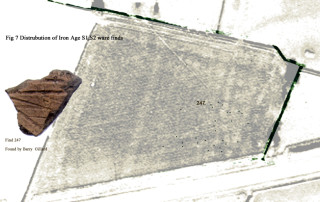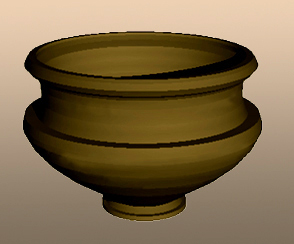Results 1: Iron Age Pottery
Roman Discoveries at Easthorpe, Bottesford
By Bob Sparham
Fabric Iron Age Sl, S2
Number of Shards 37
Percentage of Finds 8%
Distribution Mostly in Southern end of the field
Chronology c.55BC – 43AD
Some large and interesting Iron Age Shards were found. Figure 8 shows a scanned example of Grooved Ware. As can be seen from Figure 7 the position of the finds seems to be related to darker crop marks in the field. As Peter Liddel explains in his guide to Community Archaeology 2, p.24, crop marks are caused by differential growth of a crop, in this case a crop of Sugar Beet, as he writes:
“Ditches or pits dug into sub-soil will silt-up and provide a local reservoir of deep soil. retaining moisture, encouraging deep root development, and so simulating extra growth in crops and prolonging their ripening period Thus, over such buried archaeological features the ripening crop may stand out as taller and greener”
The association of find spots with crop marks in Figure 7 suggest to me two related hypothesis:
- i. That there is in the sub soil of the field a network of archaeological ditch features in which shards of pottery were buried.
- ii. That some of the features at least may predate the Roman Conquest of AD43.











No Comments
Add a comment about this page